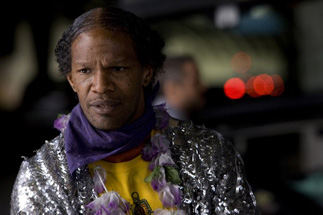|
|
Book vs. Movie: The SoloistBy Russ BickerstaffApril 27, 2009
For his part, Jamie Foxx wanted to be as true to the character as possible and he does a remarkable job here. Foxx, who had studied classical music as a child, took to learning Ayers' instruments as quickly as possible. He met and spent time with Ayers in an effort to get as close as possible to the man he would be portraying. The performance is phenomenal. The only problem here is the fact that the script doesn't allow the less endearing side of Ayers' schizophrenia to surface onto the film. Almost entirely absent is the Ayers who claimed he wasn't black, would sometimes make racist remarks and draw swastikas on the ground. Without getting into the complexity of the character's negative side, the film isn't doing the kind of job it should be doing in bringing such a fascinating person to the screen. Foxx's performance is good, but it only goes so far. Director Joe Wright made some admirable choices in putting together the film that need to be recognized here. Rather than getting a large group of SAG extras to play the homeless of LAMP and Skid Row, he spent several days with the residents there and gained enough of their trust that they allowed themselves to be used for the film. Filming on location in LAMP and around an approximation of Skid Row circa 2005 (prior to Mayor Antonio Villaraigosa's Safer City Initiative) there's a kind of a raw authenticity to the film that goes a long way toward making-up for the low-level Hollywood-ization of the story by eliminating Lopez's family. Wright was also given the opportunity to film at the LA Times on the actual floor that Lopez works on, which makes for some interesting scenes. Evidently the LA Times had never allowed people to film there before.
[ View other columns by Russ Bickerstaff ]
[ View other Book vs. Movie columns ]
[ Email this column ]
|

|
|
|

|
Friday, November 1, 2024
© 2024 Box Office Prophets, a division of One Of Us, Inc.


